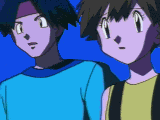 |
 |
Fundamental rules of the Pokémon Trading Card Game
1. Non-interference protocol (Pokémon Prime Directive)No card shall take any place in the opposing player's play area for any reason. Cards are written on this principal. The Chief example of this is Chaos Gym. If a card would have to go into an opponent's play field, it is discarded instead. This is to prevent the decks from being mixed together.
2. Alteration of copied names (Self-Referencing Rule)If the text of the card mentioning the name of the Pokémon on the card is copied to another Pokémon, the name is changed to that of the Pokémon copying the attack. This mainly applies to Pokémon using Metronome. For example, if Clefable copied Chansey's Double-Edge, Clefable, not Chansey, would do 80 damage to itself (Clefable would still do 80 damage to Chansey, of course).
3. Location of global attack effects (The Magby Rule)If an attack does not specify a target for its attack or specifies either player as a target, the effect of that attack lies on the attacking Pokémon, and may be stopped by in any way removing that Pokémon from the Active position. In other words, suppose Magby uses Sputter. If Magby is knocked out, evolved, gusted, scooped up, or in any way ceases to be the Active Pokémon, Pokémon Powers start working again.
4. Law of forbidden evolutions (Rule Against Illegal Evolutions)No Pokémon shall evolve into a species who does not evolve from it by exact matching of name, nor shall any Pokémon evolve where evolution is explicitly prohibited. Basically, Clefable can't Metronome Rapid Evolution and Evolve into Gyarados. Also, Ditto cannot do the same, as it is specifically prohibited from evolving. This is in the Neo Rulebook.
5. Source of Knock Out (Focus Band Rule)A Knock Out shall be attributed to an Pokémon Power or attack if the power or attack either does enough damage to Knock the Pokémon Out, places enough damage counters to do the same, states that the Pokémon is Knocked Out or when any effects of an attack produce one of the above situations within the term. In other words, Mew de-evolving a Pokémon does trigger Focus Band if the lower card has less HP than the higher card had damage.
6. Law of replacements (Substitution Rule)One object may only take the place of another object only if the second object exists to be taken place of. For example, if your opponent uses Crystal Beam, you cannot use Blaine to attach energy cards during your next turn. Similarly, if someone plays Minion of Team Rocket against a Chaos Gym and flips tails, then the other player uses the card and fails to get 2 heads, nothing happens (other than discarding the card), as the player has no turn to end.
7. Definition of playing a card (Aerodactyl Rule)A card shall be considered played when it is taken from the hand and put it into the play area. This is why pulling an evolution card from your deck using Energy Evolution or Emerge gets around Aerodactyl.
8. Typing of Energy cards (Provision Rule)Energy cards are considered to be cards of the type of energy they provide or count as. If a card provides or counts as more than one type at a time, it is considered to be all of the types it provides or counts as. In other words, a Rainbow energy counts as all types of cards at once and a Lightning Energy card treated as Psychic Energy by Ditto is a Psychic Energy card.
9. Modification of card types (Fossil Egg Rule)If a card's type is modified from what it would normally be, it is considered to be a card of its new type. This means a card played with Fossil Egg is a Basic Pokémon, and therefore gets around Aerodactyl's power. A Mysterious Fossil is also considered a Basic Pokémon, but only while it is in play, and is subject to Slowking and the like.
10. When turns end (A Rather Fitting Rule)A player's turn ends when any of the following things happen: The player uses an attack, indicates that he or she wishes to end his or her turn without an attack, or when a player is directed to end their turn by a card. The main confusion about this lies in attacks that don't do any damage, as well as Pokémon Powers and trainer cards that end your turn.
Gee, maybe I should have called this the 10 Commandments of Pokémon. In any event, there are obviously many more rules in the game, but these are some of the more prominent ones. Of course, there are exceptions to some of these, but that's why there's a Compendium.
|